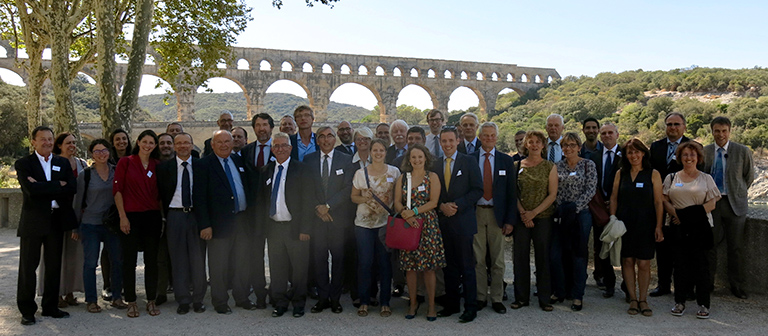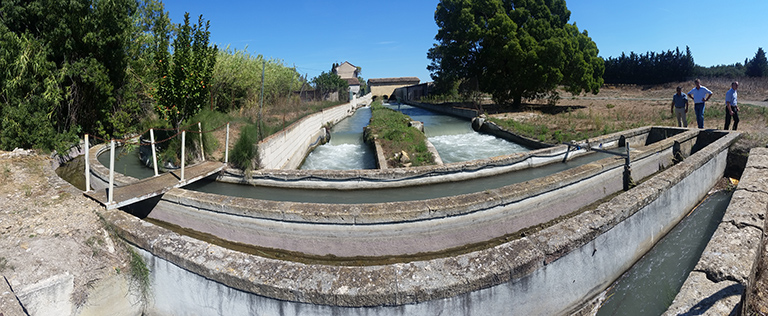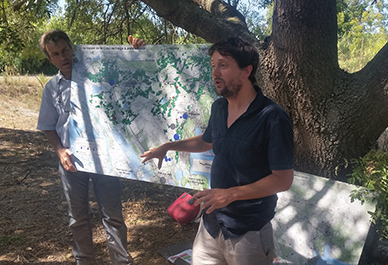A view from Europe: EUWMA 2017, Avignon

On Monday 4 September, Robert Caudwell, Vice Chairman, and I attended on behalf of ADA the 22nd Annual Meeting of EUWMA, hosted by our French colleagues, the Association Nationale des Associations Syndicales de Propriétaires (ANASP), at the Pont du Gard, an ancient Roman aqueduct near Avignon, Provence.
Water issues across Europe
It was clear from the meeting that local water management authorities across southern Europe had experienced a very dry 2017. Italy had the driest year to date in the current century which has followed 15 years of drier than average weather. France experienced the driest winter/spring for 60 years and Portugal its hottest spring since 1931, and one of the driest, which has contributed to severe forest fires. The concern in all three nations and Spain is now regarding water quality and for groundwater and flash flooding (see Livorno, Italy) as rain arrives this autumn.
Meanwhile, weather in northern Europe has been more benign, although parts of Germany had suffered from flooding with €50M of damages in Lower Saxony.
In Belgium the Flanders Government is re-organising water management, which is welcome given it currently has a complex three tier structure of watercourses involving a national environment agency, municipalities, provinces and the 63 local wateringues (water boards). The wateringues have been frustrated by being excluded from the process and this causes concerns that local engagement may be reduced in the future.
EUWMA matters
EUWMA discussed that 2019 will be significant for water matters in the EU as this is when the Water Framework Directive will next undergo a review. EUWMA agreed that the position agreed in the Frankfurt Declaration in 2016 remains the priority for members across Europe. The declaration seeks to retain the objectives of the WFD but extend the time period for deliveries good status/potential beyond 2027 (given this will not be delivered by counties across Europe), move forwards from the ‘one out all out’ principal which is limiting improvements in water management to watercourses currently further from good conditions, and seek a better definition of heavily modified water bodies to reflect their cultural and societal importance.
EUWMA also discussed an Avignon Declaration on sustainable energy and energy efficiency. ADA has been assisting the drafting of the Declaration with the EUWMA secretariat and our German colleagues who proposed the topic last year and demonstrated its value at the mid-term meeting in Dithmarschen. The Declaration will be published at www.euwma.org during October.
With ANASP holding the EUWMA presidency in 2017/18 it was announced that they would like to use it to better understand the different funding sources and opportunities available to local water management bodies across Europe and how this differs between nations. The French Association is currently building up its membership to strive to include all of the Associations Syndicales Autorisées (ASAs) involved in irrigation and drainage management, many of these are very small with a turnover of under £25,000 per year. ADA supported this proposal and think that it may prove helpful to highlight positive funding avenues IDBs may wish to explore in the future.
There was a brief session to discuss Brexit led by Robert Caudwell and I where we highlighted the ongoing process regarding EU-UK talks and the repeal bill currently before Parliament. We stressed that until we actually leave, EU law continues to apply and thereafter the repeal bill is intended to in effect transcribe all EU law into UK law. Thus it is likely to be many years before UK water and environmental legislation diverges significantly from that of the EU and trade agreements will likely ensure consistency broadly remains.
There is an irony that many EU countries are expecting a greater focus on pillar 1 funding through the Common Agricultural Policy (CAP) post-Brexit with potential reductions in pillar 2 for public goods such as the environment and flooding, whilst Michael Gove has intimated the opposite direction of travel in the UK when we create our own agricultural policy.
The ANASP intend to hold a mid-term meeting for EUWMA members on the financing of local water management in Montpellier during spring 2018 before FENACORE from Spain host the Annual EUWMA meeting in Córdoba in September 2018.
Water management in Provence
On the following day the ANASP provided a tour of their members’ significant water management sites in Provence. The majority of which are related to irrigation and water transfer from the Rhône and Durance rivers. The Canal De Carpentras is the largest ASA devoted to water transfer for irrigation in France, irrigating an area of 10,600 hectares. Demands for water have led to some of the secondary irrigation network being modified to pressurised systems rather than reliant on gravity. The system we visited had been funded by the EU and Departmental Chamber of Agriculture. We also visited the location where the Canal draws water from the Durance at one of several dams on the river managed by EDF energy. Water held back behind these dams is transferred into other man-made channels managed by EDF where the water passes through a series of hydroelectric power plants before re-joining the Durance (more info in this pdf from EDF). In this way the energy produced, as well as the load on the network, can be better regulated. However, despite quantities of water being reserved by legal agreement for use in agriculture there are challenges. EDF are lobbying the French Government to reduce the quantity of water available for irrigation. This could potentially impact crop production and groundwater recharge in the future as climate change reduces snow melt from the Alps that feeds the river.
|
Ian Moodie, Technical Manager, ADA
Archive
- March 2025
- February 2025
- January 2025
- December 2024
- November 2024
- October 2024
- September 2024
- August 2024
- July 2024
- June 2024
- May 2024
- April 2024
- March 2024
- January 2024
- December 2023
- November 2023
- October 2023
- September 2023
- August 2023
- July 2023
- June 2023
- May 2023
- April 2023
- March 2023
- February 2023
- January 2023
- December 2022
- September 2022
- August 2022
- July 2022
- June 2022
- May 2022
- April 2022
- March 2022
- February 2022
- January 2022
- December 2021
- November 2021
- September 2021
- July 2021
- May 2021
- March 2021
- February 2021
- January 2021
- December 2020
- November 2020
- October 2020
- September 2020
- August 2020
- July 2020
- May 2020
- April 2020
- March 2020
- February 2020
- January 2020
- December 2019
- November 2019
- October 2019
- September 2019
- August 2019
- July 2019
- June 2019
- May 2019
- April 2019
- March 2019
- February 2019
- January 2019
- December 2018
- November 2018
- October 2018
- September 2018
- August 2018
- July 2018
- June 2018
- May 2018
- April 2018
- March 2018
- February 2018
- January 2018
- December 2017
- November 2017
- October 2017
- September 2017
- August 2017
- July 2017
- June 2017
- May 2017
- April 2017
- March 2017
- February 2017
- January 2017
- October 2016
- September 2016
- August 2016
- July 2016
- June 2016
- May 2016
- April 2016
- March 2016
- January 2016

 Finally we visited
Finally we visited 